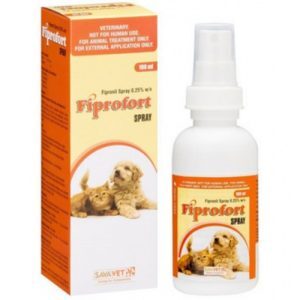Table of Contents
Fipronil is an antiparasitic agent effective against fleas, lice, mosquitoes, otomycosis (ear mites), and ixodid ticks in cats and dogs. It is used for managing and averting allergic flea dermatitis and addressing infection caused by chewing lice.

What is Fiprofort?
Fiprofort, developed by Savavet, is an anti-flea and tick spray containing Fipronil as its active component. Fipronil, a broad-spectrum insecticide, acts on fleas, ticks, and lice present on the coat. It exerts its effects by directly impacting the central nervous system. Fiprofort comprises 0.25% w/v fipronil.
Ingredients
Fipronil, a potent active ingredient in many pet medications, is celebrated for its effectiveness against fleas, ticks, and lice. By disrupting parasites’ nervous systems upon contact, it swiftly halts their functions. Widely used for treatment and prevention, Fipronil addresses flea infestations, allergic reactions, and disease transmission. Responsible use is crucial for safety and optimal results. In pet care, Fipronil remains a vital tool in the fight against parasites, ensuring our pets’ well-being.
Dosage Size
Fiprofort is intended exclusively for external veterinary use. Avoid contact with eyes and mouth. Ensure spraying is done away from open flames. Prevent animals from ingesting the spray, and keep them away from heat sources until it dries. Refrain from shampooing for at least 48 hours before and after fipronil treatment. When spraying, use gloves and wash hands thoroughly post-application. Do not directly spray onto damaged skin.
How to Use Fiprofort Spray on Your Pet
Using fipronil spray on your pet requires careful application to ensure effective parasite control. Here’s a step-by-step guide on how to apply it:
- Prepare Your Pet: Ensure your pet is calm and comfortable. Gently brush their coat to remove any tangles or debris.
- Wear Gloves: Before handling the spray, wear disposable gloves to protect your hands and prevent the spray from coming into direct contact with your skin.
- Application: Part your pet’s fur to expose the skin. Hold the spray nozzle about 6-12 inches away from the skin and apply the spray in a steady, even motion. Start from the neck and work toward the tail, covering the entire body. Avoid the eyes, mouth, and any open wounds.
- Fur Separation: For pets with dense fur, use your fingers to gently separate the fur and ensure the spray reaches the skin. This is particularly important for long-haired pets.
- Dosage: Apply the appropriate amount of spray according to your pet’s weight and the product label instructions. Avoid over-application, as this won’t enhance efficacy and might increase the risk of side effects.
- Allow Drying: Allow the sprayed area to dry completely before allowing your pet to interact with other pets or furniture. Prevent licking or grooming until the spray is fully dry.
- Post-Application: After applying the spray, wash your hands thoroughly with soap and water. Dispose of the gloves and any packaging appropriately.
How Often to Use Fiprofort Spray
Common application intervals include:
- Monthly: Fiprofort spray protects for about a month, making monthly applications necessary.
- Long-Lasting: In some cases, it offers protection for extended periods, ranging from 2 to 3 months. Follow the label instructions to determine the appropriate reapplication schedule.
Always adhere to the recommended application interval indicated on the product label. Applying too frequently can lead to unnecessary exposure, while under-application might result in inadequate protection. If you need clarification on the application frequency, consult your veterinarian for guidance based on your pet’s specific needs.
Important Safety Information
Fipronil spray suits puppies and kittens aged two months (not less than six weeks). It can also be applied to dogs weighing under 2 kg and cats weighing under 1 kg. It is safe for feline application. Potential local pruritus or hair loss may occur at the application site.
Fipronil spray is intended for external use on your pet’s coat. Avoid contact with eyes, mouth, and open wounds. If accidental contact occurs, rinse thoroughly with water. When applying the spray, maintain a safe distance from open flames, sparks, and heat sources to prevent any risk of ignition. Wear gloves while applying the spray to minimize skin contact. After application, wash your hands thoroughly with soap and water.
Choose the appropriate dosage size based on your pet’s weight. Incorrect dosing could lead to inadequate protection or potential adverse effects. Prevent your pet from licking the treated area until the spray fully dries. Ingestion could lead to unwanted side effects.
Apply the spray evenly, ensuring full coverage of your pet’s coat. Avoid spraying directly onto damaged or irritated skin. Be cautious when applying the spray around your pet’s face. Avoid spraying near the eyes and mouth to prevent irritation.
Monitor your pet after application for any signs of discomfort, itching, or redness. If these symptoms persist, consult a veterinarian.
Refrain from shampooing your pet for at least 48 hours before and after applying the spray to ensure optimal efficacy.
Veterinary Prescription
Fiprofort spray for pets is available over the counter without a prescription. These products are typically marketed as topical treatments for flea and tick control. However, regulations can vary based on location and local laws and may change over time.
Check with your local veterinary clinic, pet supply stores, or online retailers that sell pet medications. Consulting your veterinarian is always a good idea if you need more clarification about whether you need a prescription to purchase this product. They can guide the appropriate product for your pet’s needs and any relevant prescription requirements in your area.

Interactions
The potential for direct interactions with other medications is limited since the spray is applied externally to the pet’s coat. However, it’s always advisable to exercise caution and consult your veterinarian before combining any medications or treatments for your pet. Here are a few points to consider:
- Topical Medications: If your pet is already on other topical medications, such as shampoos, ointments, or spot-on treatments, it’s important to discuss potential interactions with your veterinarian. They can advise you on the timing and compatibility of multiple topical products.
- Systemic Medications: Fiprofort spray is primarily localized on the coat and skin. However, if your pet is taking systemic medications (such as oral medications), consult your veterinarian to ensure there are no potential interactions.
- Medical Conditions: If your pet has existing medical conditions, it’s essential to inform your veterinarian before using new treatments, including fipronil spray. Certain medical conditions impact the safety or efficacy of using certain medications concurrently.
- Puppies and Kittens: Young animals may have different sensitivities or requirements. Consult your veterinarian before using any new treatments on puppies and kittens.
- Pregnancy or Nursing: If your pet is pregnant, nursing, or intended for breeding, it’s advisable to consult your veterinarian before using any new treatments.
- Allergies: If your pet has a history of allergies or sensitivities, inform your veterinarian before using any new products.
Always follow your veterinarian’s recommendations and read the product label and instructions carefully before using any medication or treatment on your pet. Since circumstances can change and new information might be available, it’s recommended to consult your veterinarian or a trusted pet healthcare professional for the most current advice on interactions with fipronil spray or any other pet medications.
Side Effects
Fiprofort spray is commonly used to control fleas, ticks, and other external parasites in pets. While it is generally considered safe and effective when used according to the manufacturer’s instructions and under veterinary guidance, side effects may be possible. Some potential side effects of fipronil spray on pets include:
- Skin Irritation: Pets may experience mild skin irritation at the application site. This can manifest as redness, itching, or localized hair loss. If irritation persists or worsens, contact your veterinarian.
- Hypersensitivity Reactions: Some pets may be hypersensitive to the ingredients in the spray, leading to more pronounced skin reactions. These reactions could include excessive itching, swelling, or inflammation.
- Salivation or Licking: Pets might display increased salivation or licking behaviors shortly after application as they try to groom themselves. It’s essential to prevent your pet from ingesting the spray until it dries.
- Behavioral Changes: In rare cases, pets might exhibit changes in behavior after application, such as restlessness, lethargy, or increased sensitivity to touch.
- Respiratory Irritation: Overapplication or accidental inhalation of the spray mist could potentially lead to respiratory irritation in some pets. This is more likely to occur if the product is misused or on the wrong species (for example, using a dog product on a cat).
- Allergic Reactions: Like with any supplement, there’s a minimal chance that pets might have an allergic reaction to Fipronil or other ingredients in the spray. Signs of an allergic reaction could include swelling, hives, difficulty breathing, or severe itchiness.
- Digestive Upset (Ingestion): While fipronil spray is designed for external use, ingesting it (such as when pets lick themselves) could lead to digestive upset or other adverse effects.
Side effects are relatively uncommon, and many pets tolerate Fipronil spray well. However, if you notice any unusual or severe reactions in your pet after applying the spray, it’s recommended to discontinue use and contact your veterinarian for guidance.
Overdose
Like with any medication, an overdose of Fiprofort spray can lead to adverse effects and health complications in pets. It’s important to follow the recommended dosage and application instructions provided by the manufacturer and your veterinarian. If you suspect your pet has been exposed to an excessive amount of fipronil spray, consider the following steps:
- If you believe your pet has been overdosed with fipronil spray, immediately contact your veterinarian or an emergency veterinary clinic. They can provide guidance based on your pet’s size, weight, and the amount of spray applied.
- Keep a close eye on your pet for any signs of unusual behavior, distress, or adverse reactions. Overdose symptoms may include excessive salivation, vomiting, diarrhea, tremors, seizures, or disorientation.
- If the overdose just occurred and your pet’s skin is still wet from the spray, consider gently rinsing them with lukewarm water to remove excess product. Be cautious not to cause additional stress to your pet.
- Prevent your pet from licking the treated area until the spray fully dries. Limit their access to the sprayed area to minimize ingestion.
- If you contact a veterinarian, have the product label and information on hand. This can help them assess the situation more effectively.
Remember that it’s always better to err on the side of caution. If you need clarification about the appropriate dosage or have concerns about using fipronil spray on your pet, consult your veterinarian before applying the product.
Storage
Store the Fiprofort spray in a cool, dry place. Extreme temperatures, both hot and cold, can affect the stability and potency of the product. Avoid storing it in areas exposed to direct sunlight or high humidity. The ideal storage temperature for fipronil spray is below 30 degrees Celsius (86 degrees Fahrenheit). Avoid exposing the product to temperatures above this range.
Keep the spray in a location that is away from direct light. Dark or opaque storage areas help prevent degradation caused by exposure to light.
Store the spray in a place that is inaccessible to children and pets. This helps prevent accidental exposure and ingestion. Avoid storing the spray in freezing conditions, as freezing temperatures can compromise the product’s effectiveness.
Drugs Similar to Fiprofort Spray
Fipronil is a commonly used active ingredient in pet flea and tick control products. If you’re looking for alternatives to fipronil spray, there are several other active ingredients that also target fleas, ticks, and other external parasites in pets. Some of these alternatives include:
- Pyrethroids (e.g., Permethrin): Pyrethroids are insecticides commonly used in pet products to control fleas and ticks. Permethrin is a pyrethroid often used in spot-on treatments, collars, and sprays for pets.
- Imidacloprid: Imidacloprid is another insecticide used in pet flea control products. It is often combined with other ingredients to provide comprehensive protection against fleas and their life stages.
- Selamectin: Selamectin is used in topical treatments for fleas and certain types of worms in pets. It is effective against various parasites, making it a popular choice for comprehensive protection.
- Spinosad: Spinosad is derived from a naturally occurring soil bacterium and is used in oral flea control medications for pets. It’s effective against fleas and can provide rapid relief.
- Lufenuron: Lufenuron is an insect development inhibitor. It doesn’t directly kill adult fleas but prevents flea eggs and larvae from developing, breaking the flea life cycle.
- Fluralaner: Fluralaner is commonly found in oral chewable medications for dogs and cats that provide long-lasting protection against fleas and ticks.
- Nitenpyram: Nitenpyram is an oral medication that quickly kills adult fleas on pets. It’s often used as a short-term solution to reduce flea infestations rapidly.
- Sarolaner: Sarolaner is found in chewable tablets for dogs, providing protection against fleas and ticks for an extended duration.
When considering alternatives to fipronil spray, it’s essential to consult your veterinarian.
FAQ
Is Fiprofort safe for my pet?
When used as directed and in appropriate doses, Fiprofort is generally considered safe for pets. However, consult your veterinarian before use, especially if your pet has pre-existing health conditions.
Can Fiprofort be used on puppies and kittens?
Fiprofort can often be used on puppies and kittens aged over six weeks or two months. Check the product label for specific age and weight requirements.
Can my pet swim or be bathed after using Fiprofort?
No, this product requires your pet to stay dry for a certain period after application.
Can Fiprofort be used alongside other medications?
Discuss any concurrent medications with your vet. While topical products like fipronil spray have limited interactions, consulting a professional is best.
Can Fipronil be toxic if my pet ingests it?
Ingesting Fipronil is not intended and could lead to adverse effects. Prevent your pet from licking the treated area until the spray is dry to minimize the risk of ingestion.
Olivia Bennet is a veterinarian who has worked in a veterinary clinic for many years. She specializes in the diagnosis, disease prevention, and treatment of not only cute kittens and puppies but also large farm animals. Olivia loves animals, cares about them, and wants to help you know more about your pets.

































